A sound sales strategy is to sell something no one else is selling. Ideally, that something being something people need and want . . and can afford.
How about a plug-in hybrid minivan?
That’s a species of minivan – and hybrid – only one brand offers at the moment.
WHAT IT IS
Chrysler’s Pacifica plug-in van is as unique in its way as the original Prius was in its way – way back in the late ‘90s, when it first appeared. At the time, no one else had anything like it, either. So the Prius had the market entirely to itself for awhile.
Same thing here – and in more ways than one.
Unlike the original Prius – which used its gas-burning engine as a carry-it-with-you-generator to charge up its batteries as you drove – you can charge up the Pacifica’s batteries without driving it at all.
Just plug it in to a household outlet.
You can also drive the Pacifica at normal road speeds without burning any gas at all – and for 30-something miles.
The original Prius – and non-plug-in hybrids generally – could only creep along at low speeds on battery power.
To actually get going – or get very far – you had to burn gas.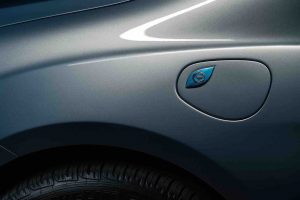
And still do.
All current hybrids that aren’t plug-in hybrids rely mostly on their gas-burning engines to get going. The battery pack and electric motor are there to provide supplementary power, to assist the gas engine during acceleration and to power accessories when the car isn’t moving – and to help maintain motion once they are moving.
And even if it weren’t a plug-in hybrid, the Pacifica is the only hybrid minivan you can buy right now.
So if you’re interested in that, there’s not much cross-shopping to do!
Base price is $39,995 for the Touring trim; a top-of-the-line Limited trim stickers for $44,995.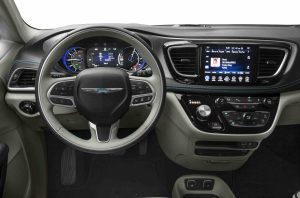
Which brings up something else that’s interesting.
While there is a huge difference in price between the least-expensive version of the plug-in Pacifica ($39,995) and the least-expensive version of the non-hybrid Pacifica ($26,995) there is almost no difference between the price of the top-of-the-line Pacifica Limited plug-in ($44,995) and the price of the non-hybrid Pacifica Limited ($44,295).
If you can afford the Limited, it’s almost a n-brainer to buy the plug-in version since it only costs $700 more and you will make that back in gas savings.
It’s also much more competitive – for the same reason – with the higher end versions of non-hybrid vans like the Toyota Sienna ($47,530 for a top-of-the-line Limited trim) and the Honda Odyssey ($46,970 for a top-of-the-line Elite trim).
But the $13,000 difference between the base-trim Pacifica plug-in and the base trim non-hybrid Pacifica (and the lower-priced versions of the Sienna and Odyssey) is going to take a lot of years – and a lot of miles – to work off in savings at the pump.
Chrysler has added a sporty S appearance package to the roster of options. It’s similar in theme to the S package that Chrysler first offered as an option with the 300 sedan. It includes black Black Noise 18 inch wheels and gloss black trim throughout, with offsetting Light Diesel Gray interior accents to match.
Touring L trims get a standard heated steering wheel and Touring Plus trims get an upgraded Theater version of the UConnect touchscreen with wireless streaming capability.
Goes pretty far – and fast – without burning any gas at all.
Smoother – and quieter – than non-hybrid Pacifica.
Much more fuel-efficient than other full-sized vans.
No loss of cargo capacity behind third row.
WHAT’S NOT SO GOOD
Second row does not stow and go (as it does in the non-hybrid Pacifica) because the room under the floor is taken up by the batteries.
Isn’t available with AWD.
This is a luxury plug-in hybrid – and priced accordingly.
Plug-in hybrids like the Pacifica are better-categorized as part-time electric cars.
With its 16 kWh lithium-ion battery pack fully charged up, the Pacifica can be driven about 33 miles without the gas engine coming on at all.
This has a number of advantages – for you as well as Chrysler.
Probably the most important advantage – for you – is that unlike an electric-only car, you’re not tied to an electric umbilical cord. If the charge runs low, you still can go – because the 3.6 liter V6 automatically steps in to spell the wilting battery.
And you can go far.
The combined range of the electric-gas hybrid powertrain is 566 miles – stupendously more range than any currently available electric-only car offers.
There’s also no waiting when you run out of range – gas or electric.
Or at least, you don’t have to wait. To recharge. Do it when it’s convenient for you. Or gas up – in about 5 minutes – vs. at least 30-45 minutes for a partial recharge in a full-time EV.
Full-time electric cars haven’t got that flexibility. When the batteries wilt, you have to stop to recharge – whether it’s convenient or not. And then, you wait.
The big advantage of the hybridized Pacifica for Chrysler is that the plug-in Pacifica helps uptick its Corporate Average Fuel Economy (CAFE) numbers. These are the minimum miles-per-gallon numbers decreed by the bureaucrats in DC, which every car company must meet or else get socked with “gas guzzler” fines that they then pass on to buyers.
These fines, of course, make the “gas guzzlers” more expensive- and so a harder sell.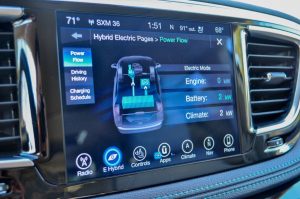
Chrysler needs the help more so than other car brands, too – because Chrysler currently has only one other model in its lineup, the 300 sedan. Which is a big, heavy sedan that is powered by big V6 and V8 engines. Which are wonderful engines (especially the Hemi V8) but not exactly the kinds of engines that appease the fuel-efficiency mania of the regulatory ayatollahs.
By adding a plug-in hybrid version of the Pacifica to the mix, Chrysler’s CAFE math becomes more favorable.
But, the math is confusing – and needs some explaining.
The Pacifica plug-in’s window sticker reads “84 MPGe” – a figure arrived at by calculating the Pacifica’s ability to burn no gas at all for 33 miles factored by the mileage boost it gets just from being a hybrid, even when it is burning gas.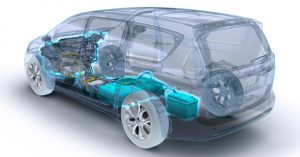
But don’t expect 84 MPG – “e” or otherwise – unless you almost never run the batteries low and almost always keep them charged up.
Remember: After about 33 miles – less, if you didn’t start out on a full charge – and less, if you drive with a heavy foot, which will run the charge down faster – the gas engine comes on and at that point, the Pacifica is mostly running on the gas side of the powertrain (assuming you’re moving).
And at that point, you will probably average about what I did during my weeklong test drive, which was just under 30 MPG. This is about 10 MPG better, on average, than the non-hybrid Pacifica.
But it’s nowhere near 84 MPG.
To be fair to Chrysler, that might be achievable – if your drive is within the orbit of the Pacifica’s electric-only range – and if you remember to keep the batteries charged most of the time. And if you keep your right foot light.
Otherwise, expect that your actual mileage will vary.
Here’s another interesting thing about the Pacifica plug-in: It drives better than the non-hybrid Pacifica.
A big part of the reason why is that the plug-in hasn’t got the nine-speed automatic transmission used in the non-hybrid version of this van. That box has too many gears for not enough speed. America is not Germany and most of the time, most of us are not driving much faster than 70 and that’s on the highway. In traffic, it’s more like running it up to 40 or so, then back to zero at the next light… and repeat. The nine-speed’s arguably got three too many gears for that kind of driving.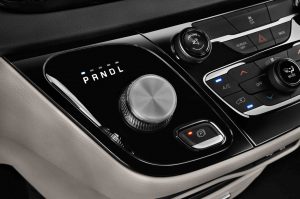
It has to do too much shifting – both up and down. And in between. This isn’t a Chrysler problem, either. It is a problem common to these more than six forward gears transmissions, which are coming online because (bet you can guess) of CAFE regs. The tighter gear spacing – and multiple overdrive gears – is helpful in terms of squeezing out an extra 2-3 MPG vs. a six-speed automatic. The difference is negligible from the standpoint of the buyer/driver – but it’s really important from the standpoint of the manufacturer (i.e., Chrysler) and the need to appease the fuel efficiency fatwas.
But the plug-in Pacifica hasn’t got this “shifty” problem – because it has a different transmission – a type of continuously variable (CVT) transmission Chrysler dubs the eFlite or Si-EVT transmission. There is no shifting at all. Just turbine like continuous – and very quiet – acceleration.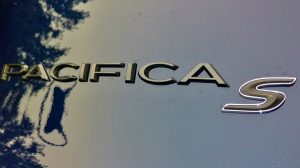
And this quiet is made even quieter – when in EV, or electric vehicle mode – by the absence of any engine noise at all. Just like an electric car – but without the range anxiety.
And it accelerates nearly as quickly as the non-hybrid Pacifica – even though it is several hundred pounds heavier (the batteries, mostly) and has slightly less total horsepower – 260 vs. 287 in the non-hybrid.
The regular Pacifica gets to 60 in a quick 7.5 seconds; the plug-in gets there in a 7.8 – a difference measurable by the stopwatch but not the seat of the pants. If anything, the hybrid fees stronger because of the immediate thrust delivered by its high-performance battery pack and motors (there are two of them).
Off the line and part-throttle, especially.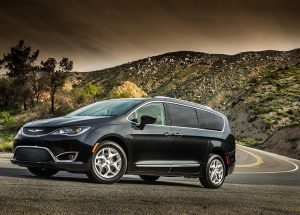
Otherwise, this part-time electric van drives like the standard van – which is probably a function of the superior (vs. most hybrids, plug-in and otherwise) weight distribution. There is more room in a full-sized van for the battery pack; the cells (96 of them) can be spread out over the length (and width) of this long (and wide) vehicle – as opposed to bunched up under the trunk.
So even though this van is heavy, it is not top-heavy. If anything, it feels more stable than the non-hybrid Pacifica because that weight hunkers it down.
The one thing it does have in common with the standard Pacifica is its size. This thing is a bus – 203.8 inches end to end, which is longer end to end than either the Sienna (200.6 inches) and the Odyssey (203.2 inches).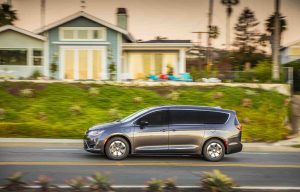
None of these are “mini” vans. All of the current models are two-feet-plus longer than the original (and actually mini) vans of the ’80s.
But, the Pacifica’s size is leavened by its comparatively short hood, which gives you an almost cab-forward view of the world and also tightens up the maneuvering – or at least makes it feel less intimidating when maneuvering.
A 360 degree Surround View camera system helps in close quarters and you can also get automated parallel and perpendicular parking assistance.
Just be aware that size does matter – in terms of where this bus fits, both on the street and in your garage.
Minivans have changed – and not just in terms of their no longer being “mini.”
They’ve become expensive – because they’ve become opulent and luxurious – more for parents whose kids have left the nest than for parents with kids in the nest – who will slop up the interior of whatever vehicle they’re carted around in.
It is not an exaggeration to describe the current crop of not-mini vans as smaller-scale RVs, whether electrified of not.
Even the “base” version of the Pacifica hybrid comes with three-zone climate control AC, HD satellite radio, an 8.4 inch Uconnect touchscreen and power pretty much everything (including both sliding doors). To this you can add heated seats, a 20-speaker Harman Kardon premium stereo rig, heated and ventilated (and leather) seats and an upgraded Uconnect system that streams Blue Ray vids through dual rear seatback high-definition flatscreens.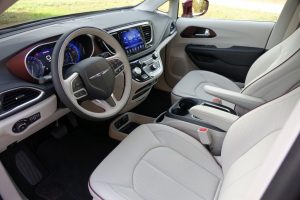
But minivans are also still practical – even more so than the crossover SUVs that have largely taken over the former role of minivans as the family haulers of most people’s choice.
Because crossovers don’t look like minivans.
It’s not that minivans are unattractive. At least, they aren’t ugly.
But they are associated in many people’s minds with screeching kids and the quiet desperation of the cul-de-sac and even if crossovers are used for the same purposes, people seem to prefer them because crossovers have been very successfully marketed as “sportier.”
Still, not even a full-sized SUV can touch the cavernous capacity of a full-sized minivan. The Pacifica has 140.5 cubic feet of total cargo capacity – a bit less than the Sienna’s 150 cubic feet and the Odyssey’s 155.8 cubic feet – but regardless, it’s a lot of space.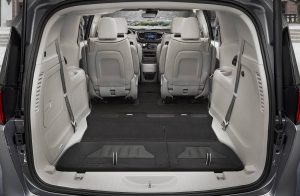
For perspective: A Chevy Tahoe – which is a full-size SUV (with a V8) only has 94.7 cubic feet of cargo capacity and the Chevy is 204 inches long, weighs 1,000 lbs. more than the Pacifica and uses easily twice as much gas.
Minivans are also easier to get into – and out of.
The lower step in height is a real plus; no need for grab handles (or ladders). The sliding doors also allow much better access to all the interior space.
Aside from the high cost of saving money on gas, the main Pacifica plug-in’s main negative is that you can’t “disappear” the second row seats into the floor – which you can in the regular Pacifica. The reason being that the battery pack and other hybrid gear are under the floor there. But, you can take the seats out, if you need to haul some extra-big/awkward cargo.
There’s one other deficit – maybe. Depending on what you need. The Pacifica – like all the remaining vans except the Sienna – isn’t available with AWD. This is very odd – given that almost every crossover is available with AWD – attesting to its popularity.
This means the Pacifica isn’t exactly the hot ticket for snow-day driving, and not just because no AWD. It also sits low to the ground – unlike most crossovers. You get the easy step-in height (and low load floor) but sacrifice some snow-fording capability in exchange.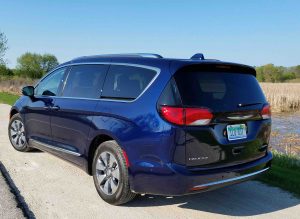
Final item: As mentioned earlier, you can buy a top-of-the-line Pacifica hybrid for just a few hundred bucks more than a top-of-the-line non-hybrid Pacifica.
And for less than a loaded/top-of-the-line Sienna or a comparably equipped, top-of-the-line Odyssey – neither of which will ever average 30 MPG.
And forget 84 MPG “e.”
THE BOTTOM LINE
With gas cheap, expensive hybrids are a harder sell – not just this hybrid, either.
But at least Chrysler hasn’t got to worry about the competition.
. . .
Our donate button is here.
If you prefer not to use PayPal, our mailing address is:
EPautos
721 Hummingbird Lane SE
Copper Hill, VA 24079
PS: EPautos magnets are free to those who send in $20 or more. My latest eBook is also available for your favorite price – free! Click here. If you find it useful, consider contributing a couple of bucks! 


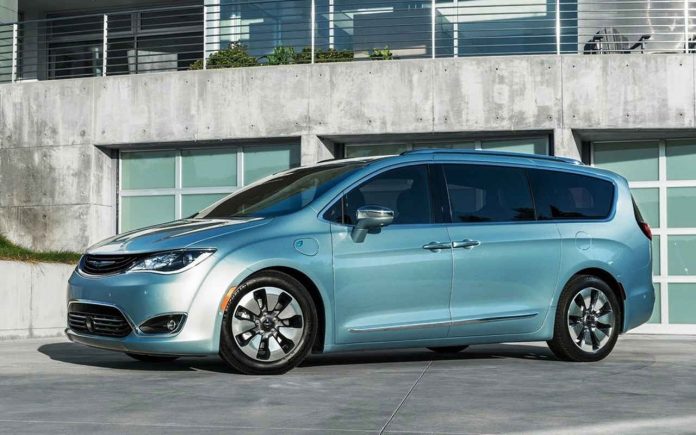

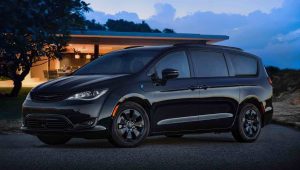



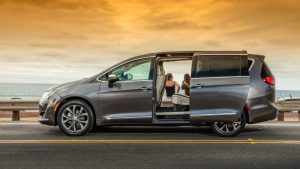
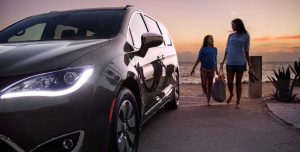







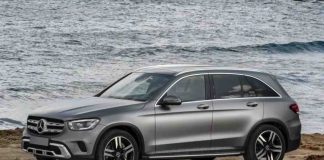
Eric, I wanted to chime in that I like your cat in the video curiously walking around the Pacifica.. Can he please get some air time/ recognition for being such a curious critter?!? Hit the homerun again with the stupid “e”MPG it’s such an obvious marketing ploy when hybrids can be such zZzZzZzZz
Hi MH,
That’s Fuzz! (the cat)… and he is supernaturally smart; he likes to inspect each new car I test drive and add his 50 cents to the review!
i rented one of these pacifica’s for a week and loved it compared to my 05′ odyssey. This thing feels fast and handles like a sedan. When it came out it really set the bar for minivans. The pacifica is the reason the new sienna and odyssey are more powerful and faster. I like the seats in this thing too compared to the last generation chrysler town and country that it replaces. Great car and great value. The odyssey and sienna are just too overpriced for what they offer.
Hi Mooeing,
Yup – plus, if times get tough, this thing is not a bad place to live in, either 🙂
The lack of a stow and go second row is actually an even bigger problem.
Makes it a much harder van to actually “live in, down by the riverside.” 🙂
Minivans suck. You don’t need to pack your whole house to take lil Johnny to foopbawl practice.
It’s a safe bet to assume a minivanner or prouder if something is creating issues on the highway. Slow AF. $45K. Suckers.
* priuser is the not word here
Hi Trufe,
I don’t think they suck – but you’re right about the expense. Minivans used to be a pretty affordable replacement for the big station wagons extincted by the government (via CAFE). But over the years, they’ve swelled in both size and price.
I don’t slam them, though. For some people, they may make sense or maybe some people just like them. Hell, my Trans-Am doesn’t make a lot of sense, either!
For a family vehicle, I much prefer something like the Ford Transit Connect. It actually is “mini” – in size as well as price!
I agree about the utility aspect Eric. My girlfriend has a most useful Honda minivan and it hurts my soul to even ride in it. Every man has his limits I suppose.
Love your website dude. Live free.
Minivans used to have two markets. The first one, which they are still marketing too, is to couples in their 60’s and 70’s, looking for that travel luxury van. The small RV, for people with some money. The other market is families with adults in their 30’s and 40’s. They must have not been buying enough of them anymore, since there are no longer making any affordable ones anymore. Most families aren’t going to spend 40k on a minivan. If they can afford 40k they are buying something else.
Have never understood the ire directed at minivans. They may not be lookers, but they aren’t ugly like many SUV’s can be.
Hi Rich,
I agree – especially since most crossover SUVs are nothing special to look at, either. Minivans just became “uncool” – much as the old 9-passenger station wagons became “uncool” – and I miss those mightily!
Interesting vehicle. If the battery charge is used up, how long does it take only using the engine to fully charge it – not using plug-in?
This is a step that could have been taken 10 years ago, but I would be willing to bet that Chrysler was waiting for the idea to become economically feasible. What a concept, providing whats in demand, rather than attempting to create a false demand for what you have to offer. Now who do you think could learn a valuable lesson from this?…….I wonder.
I wonder what a 300 outfitted with a similar power train might be like…
Hi Bryce,
I bet they thought about it… but decided against. Because the 300 in hybrid guise would have almost no trunk space, due to the batteries. That would badly gimp its appeal – it would be a big sedan with a Miata sized trunk…
Well, that, and maybe because a 300 sedan that is a plug in is like a minivan version of a Corvette — not a lot of intersection in the Venn diagram between 300 sedan buyer and a plug in buyer. Not quite as silly as a plug in Dodge Demon …
Hi Jim,
Yup, that too!
And in re the Pacifica: This thing – and things like it – cry out for a diesel engine. Much less complex and expensive; extremely efficient.
But of course, not in compliance with the “climate change” religion.
Diesel would be perfect for a vehicle that use and size. With diesel you could probably go with a four cylinder one instead of a pretty big gas V6. A gas four cylinder, even with a turbo, doesn’t cut it with a “mini” van.
Believe it or not Chrysler actually did try that very thing in the 1st Gen. Caravan. Guess what, it didn’t work so well, lol! But I’ll have to give them point for trying. Although they have been credited as inventing the minivan, that would only be true as far as it being Front Wheel Drive. Both VW and Chevrolet had the concept well sold 25 years earlier, with the Micro-Bus and the mid-sized Corvair van, respectively. Both of which were Air-cooled, Rear-engine, Rear-wheel-drive.
What Chrysler did do was to make the minivan more versatile and less truck-like than its forebears. It remains one of my favorites to this day!
There were front-drive minivans well before Chrysler’s, albeit not from American manufacturers. For example, the DKW Schnellaster:
https://en.wikipedia.org/wiki/DKW_Schnellaster
AMC had a concept for a 4WD minivan in 1977 but never made it past the mockup stage:
https://www.hemmings.com/blog/2014/07/02/amcs-concept-80-am-van-coming-to-kenosha-history-center-in-time-for-2014-kenosha-homecoming/
Hi Jason!
The who-made-the-first minivan thing is a lot like the who-made-the-first muscle car thing. Some argue it wasn’t Pontiac (1964 GTO) but rather Chrysler (letter series) or Oldsmobile or even Mercury!
But Pontiac popularized the idea of the muscle car; I think that’s pretty indisputable. And I give Chrysler the same credit as regards the minivan!
It could be argued that the 2CV was the forerunner of the minivan, having been cobbled into a local delivery van, of sorts, way back when. I think the 2CV even beats the Lada for being the most prolific automobile ever produced, even.
And as ugly as it is, no one seems to have ever been coerced into paying for one, lol!